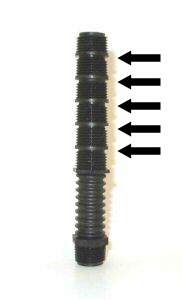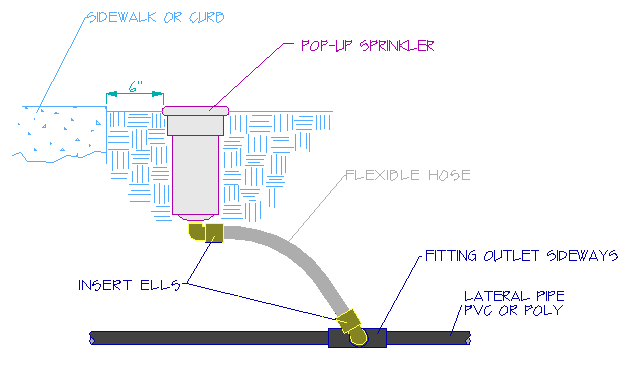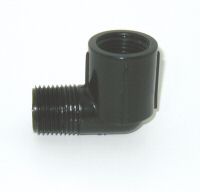The short section of tube that attaches a sprinkler to the underground lateral pipe is called a “riser”. But the riser does much more than attach the sprinkler. It must hold the sprinkler in the correct position, it must allow you to adjust the sprinkler location, and we can also use it to protect the sprinkler from damage. The riser type you use is an important choice and deserves some attention. A good riser choice can save you time and money over the years. This article will take you through the many choices and the pros and cons of each. (“Lateral pipe” is the name given to the pipes that go from the zone valve to the sprinkler heads.)
Simple Pipe Risers (i.e.; Nipples):
One of the most common sprinkler risers used for residential systems is a simple short section of pipe called a “nipple”. Nipple is the standard plumbing term used for any short section of pipe regardless of where it is used. While a nipple is the least expensive riser type, it also has some very distinct disadvantages. If the nipple is made of metal or rigid pvc plastic the nipple won’t easily break. Now this may seem like a good thing, as we don’t generally want things to break. But think for a moment, which would you prefer to break? An expensive sprinkler head, a hard to repair underground lateral pipe… or a cheap, easy to replace riser? A nipple is also non-adjustable. The sprinkler head can’t be moved from side-to-side or tilted if it is installed on a simple nipple.
If you want to go the really cheap route and use a nipple for the riser I suggest that you use a polyethylene (“poly”) nipple. Most people opt for a clever molded poly nipple called a “poly cut-off riser“. A poly cut-off riser is a short pipe section (typically 6” long) with multiple sets of threads on it (see photo below.) You simply cut it off to the desired length with a knife or a pipe cutter.
Why use polyethylene? Because the poly material is very soft, the nipple will bend under stress and spring back to the original location when the stress is removed. It also will break under less stress than a PVC or metal nipple, so it is likely to break before either the sprinkler or the lateral pipe breaks. When cutting the poly cut-off riser to the desired length always cut it at the top of one of the sections of thread, as shown by the arrows in the photo below. Cut-off nipples generally are very inexpensive. Keep in mind that sooner or later you are going to have to replace a few of them. After all, they’re designed to break! So buy a few extra when you install your system. You don’t need to use thread sealants like Teflon tape on poly risers, the soft plastic will seal itself. Amateurs should never use liquid or paste thread sealers on sprinkler systems, if some of it squeezes through the threads to the inside of the pipe the water will take it straight to the sprinkler nozzle where it will clog the nozzle.

While a simple poly nipple will work for a riser on an economically challenged install, there are better ways. So let’s move along and look at the better options.
Swing Joint Risers
A much better solution for risers is to use something designed to allow the sprinkler to move slightly. The riser most professionals use is referred to as a “swing joint” or “swing riser”. (Swing joint is an older name used, swing riser seems to be replacing it.) In addition to deflecting to prevent breakage, most swing risers also allow the sprinkler head location to be easily adjusted. With the swing riser types known as “flexible arm swing risers” and “quadruple swing risers” the sprinkler head doesn’t need to be directly over the lateral pipe fitting, so it is not nearly as critical that the pipe be installed in the right place. Thus the trenching and pipe installation is going to be much easier and faster. I don’t know about you, but I like methods that are easier and faster– especially when they also give better results! By the way, 4 to 6 inches is the normal distance a sprinkler should be from a sidewalk. (Before you ask, no, a 6 inch distance does not cause a dry spot along the edge of the sidewalk.)
Flexible Arm Swing Risers:
Don’t use these flexible arm swing risers with sprinklers that have a 3/4″ or larger inlet. See the rigid riser below for 3/4″ and larger inlet size sprinklers.

The flexible arm swing riser is cheap and easy to install but not as durable as a rigid arm swing riser (but it is still much more durable than the cut-off riser mentioned above). This is the method I recommend for a residential or even a light commercial application, and it is what I use on the majority of my fast-food restaurant irrigation systems. It provides a good balance between cost, ease, and durability. The flexible arm swing riser consists of a length of flexible pipe (sometimes referred to as “Funny Pipe ®” which is a trademarked name of the Toro Company) with a insert ell on both ends. One ell attaches to the sprinkler, the other to the lateral pipe fitting. You can buy these swing risers preassembled, or you can buy the flexible pipe and insert ells separately and assemble it yourself.
While you can still buy the parts to assemble the riser yourself, most of these are now cheaper to buy as preassembled units. The preassembled swing risers often have 3 or even 4 ells which makes them much easier to install. 4 ells makes them a lot easier to install and position. If the swing joint you purchase has only 3 ells you can duplicate this 4 ell feature by adding street ells to the risers. A street ell is just an ell that has female threads on one end and male threads on the other (see photo below.) I suggest adding a street ell to one or both ends of your swing riser to make it easier to install. The street ells you use should be high density polyethylene, which is black in color and has a slightly oily feel. “Marlex” is a common brand name of high density poly that you may encounter. Do not waste your money on white PVC street ells, they are worthless for swing risers! The threads on high density polyethylene do not seize up like PVC does, which allows the threaded joint to stay flexible.
If you are building your own flexible swing joint risers do not use more than a 18″ length of flexible pipe for your riser! The flow through this pipe is very restricted. Longer lengths cause a high amount of pressure loss and this can mess up the performance of the sprinkler head. If the head is more than 18″ away you should run a branch pipe over to it using the same size and type of pipe as the lateral.
When installing the riser do not bend the flexible pipe to help position the sprinkler. Poly pipe has what we call “memory” in the pipe industry- it tries to return to its original shape in a few hours. When it does, it will pull your sprinkler along with it and the end result will be a sprinkler that leans at a weird angle. I have even seen the pipe pull the sprinklers underground! If the pipe is curved when you buy it, work with the curve of the pipe. Twist the ells around on the end of the pipe until the sprinkler is in the position you want without bending the pipe. Cut the pipe length shorter if need be. (I recommend starting with a 12″ to 18″ length of flex pipe and then cutting it shorter as needed to position the sprinkler.) One more time; do not bend the flexible pipe. Believe me when I tell you that it will save you a lot of headaches later! You do not need to use clamps on the special insert ells that are made for swing risers. These ells are made differently than the ones used for standard poly pipe. They have a self-locking ridge on the ell that seals it and locks the flexible tube on. Most of these swing riser insert ells have spiral barbs, so you need to twist them into the pipe– just like screwing a light bulb into a socket. You do know how to install a light bulb, right? Finally, you should use Teflon tape on the male threads of the insert ells to seal them. You don’t have to use a lot of Teflon on these, a little leak here isn’t a huge problem. Again, unless you are a professional pipe fitter, I would recommend that you not use a liquid or paste type thread sealer. See my rant on that topic above in the Simple Pipe Riser section.
OK, I confess it is often not as easy to get the insert ell in as it is to install a light bulb. So if it’s cold, the flexible pipe is stiff, and the insert ell just doesn’t want to go in, here’s a trick– use KY Jelly on the insert ell barbs. Don’t use any other type of oil or soap, they can damage the plastic. Thanks to marketing, most people seem to know what KY is, unlike back when this tip was passed along to me. KY Jelly is a water-based lubricant. Don’t head for the hardware store like I did. (Now that was an embarrassing incident! Fortunately the clerk at the hardware store didn’t know what it was either, or if he did, he wasn’t letting on.) Buy it at the drugstore or supermarket, you’ll find it on Women’s hygiene aisle or near near the condoms. ‘Nuff said guys?

The photo above is a preassembled flexible pipe swing riser attached to a PVC fitting and a pop-up sprinkler. The riser in this photo is made by Hunter and features 4 ells for ease of installation and added flexibility.
Rigid Arm Swing risers:
The rigid arm swing riser is the standard riser type used for rotor heads, including the large ones found in parks and golf courses. For small rotors with 1/2″ inlets and spray heads I would recommend using the flexible swing joint described above, although there is no reason you can’t use a rigid arm swing joint if you want. But for most rotors a rigid arm swing joint is the way to go. The pipe and fittings used to make the rigid arm swing joint should be the same size as the inlet on the rotor. Rigid risers are what I use on all my higher-end systems, as well as parks and golf courses.
There are various types of rigid arm swing risers depending on how many ells the swing riser has. The double swing riser has two ells at the bottom of the rigid arm and is pretty much worthless for most situations in my (not so humble) opinion. It allows the head angle to be adjusted, but does not allow the head to be moved up or down. Double swing risers are used primarily for shrub style sprinklers mounted on a pipe above ground. The triple swing riser is much better and is the standard swing riser used by most professionals. The triple swing riser allows the head to move up and down and allows it to be angled in any direction (i.e.; you can install the head at an angle so that it is perpendicular to a slope.) But you still can’t move the sprinkler head from side to side with a triple swing riser. That’s why I use quadruple swing risers when I use a rigid arm swing riser.
The quadruple swing riser allows the sprinkler head to be moved in any direction. It can be adjusted up or down, angled in any direction, plus it can swing from side to side. For example, lets say you install your lateral pipe parallel to a sidewalk and for whatever reason, the pipe winds up being 10″ away from the edge of the sidewalk. With a triple swing riser your sprinkler is also going to be 10″ away from the sidewalk unless you install a small branch pipe over to the sidewalk from the lateral. With a quadruple swing riser you simply swing the sprinkler over so it is as close to the edge of the sidewalk as you want it to be. (Again, 4 to 6 inches is the normal distance a sprinkler should be from a sidewalk. Before you ask, no, a 6 inch distance does not cause a dry spot along the edge of the sidewalk.) A quadruple swing riser costs about a dollar more than a triple swing riser, but gives you total flexibility– which is important if you want a really efficient sprinkler system! A typical rigid swing riser is constructed using a 12 inch long SCH 80 PVC nipple for the rigid arm (generally SCH 80 is gray colored) and high density polyethylene street ells (see photo of a street ell above.) High density polyethylene is typically referred to as “Marlex”. Marlex is black in color, softer than PVC, and works better for swing risers than PVC because it has a naturally oily surface. Do not use standard threaded white or gray PVC ells on swing risers! The threads on standard PVC ells tend to stick to each other and keep the swing riser arm from moving as it should. I recommend that you use a small amount of Teflon tape on the male threads, even when using Marlex street ells. By the way, the black plastic used for the Funny Pipe ® risers mentioned earlier are not Marlex! If you can’t scratch it with your fingernail, it is not Marlex.

Several manufacturers make preassembled rigid swing risers for sprinklers. Most of these preassembled swing risers are very high quality and use special PVC ells with o-ring sealed swivels built into them. Unlike standard threaded ell joints these swivels allow very free movement of the swing riser and are superior to swing risers made with standard threaded ells. They are often used with the large, expensive sprinklers used on golf course and park irrigation systems. The large, heavy tractor mowers used on parks and golf courses make it essential that the swing risers be able to move freely.

Flexible Risers
What if you really need to bend the riser pipe? There is a very flexible pipe riser product that is now sold at most irrigation supply stores and home improvement stores. It is durable and can be bent to pretty much any position you want. Tie it in a knot if you wish. I have been very pleased with this product so I feel I can recommend it for situations where you need a really flexible riser pipe. I find it is especially useful for broken sprinkler replacements as it can be contorted to fit into a tight hole. It looks like a flexible electrical conduit. (In fact that’s exactly what it is, a flexible electrical cable protector with a length of vinyl tubing inside it!) Don’t use it for anything other than small 1/2″ inlet spray heads. It can’t withstand high pressures and the flow through it is very limited. I usually put a threaded high-density poly street ell on one or both ends which makes it much easier to install.
